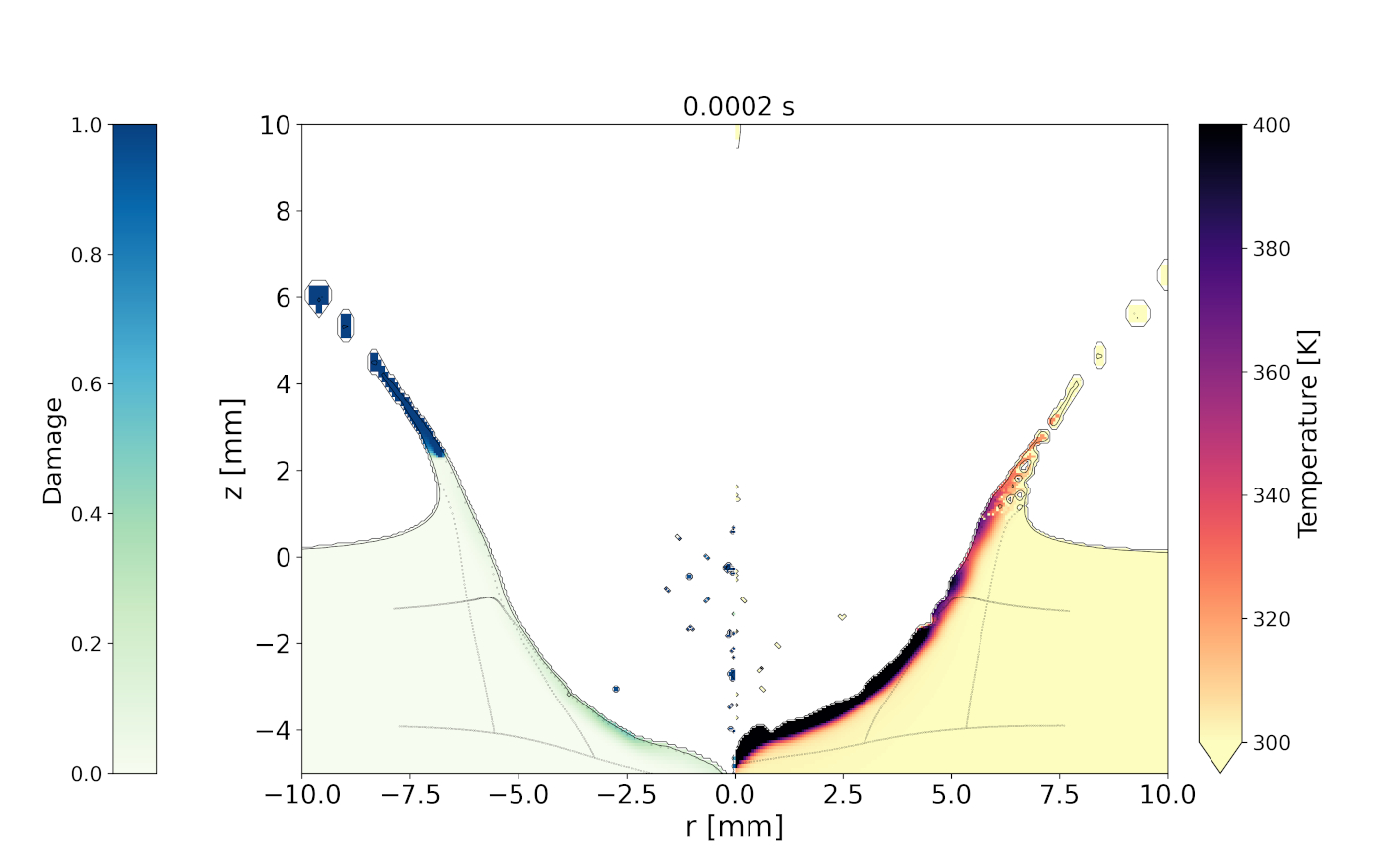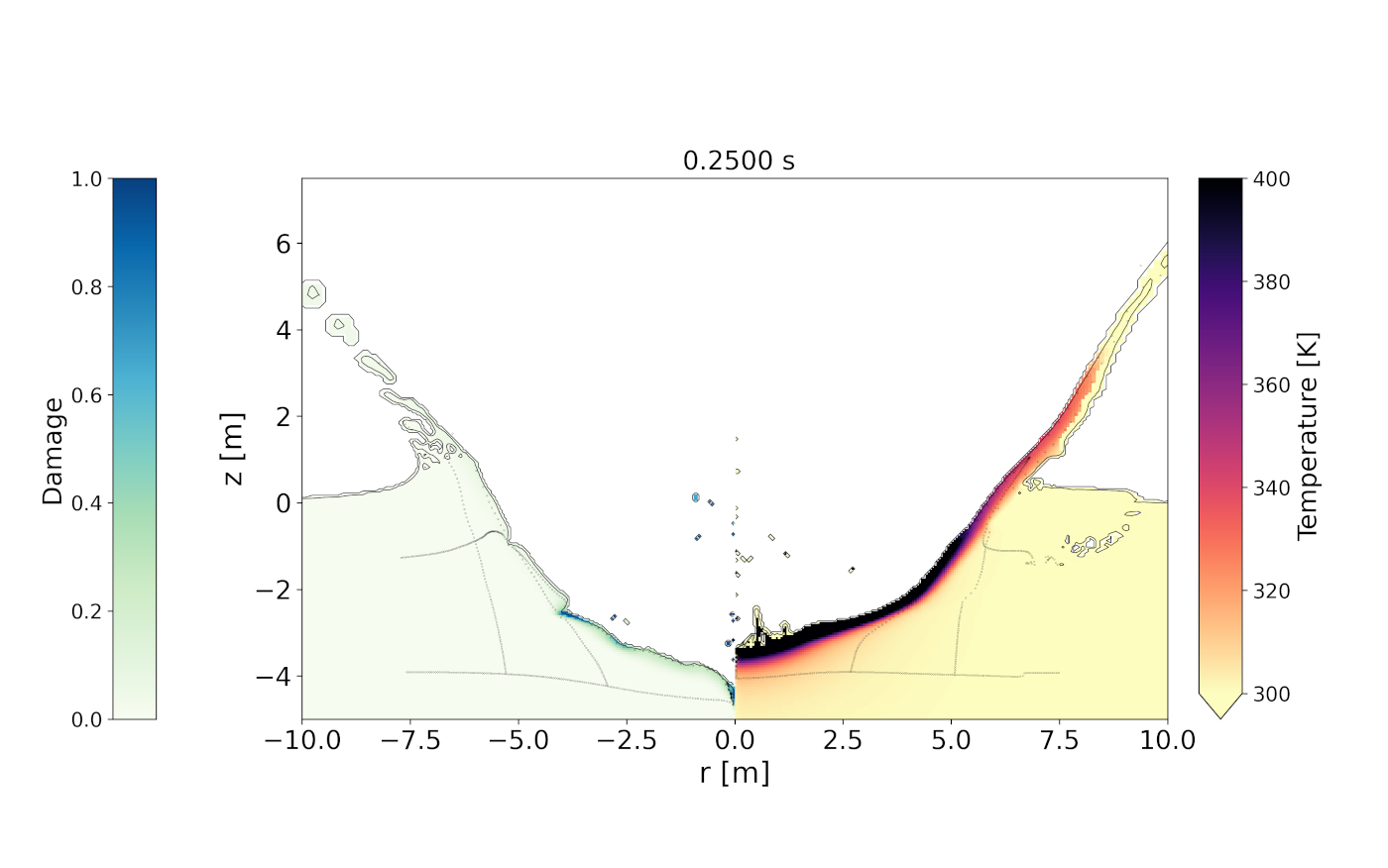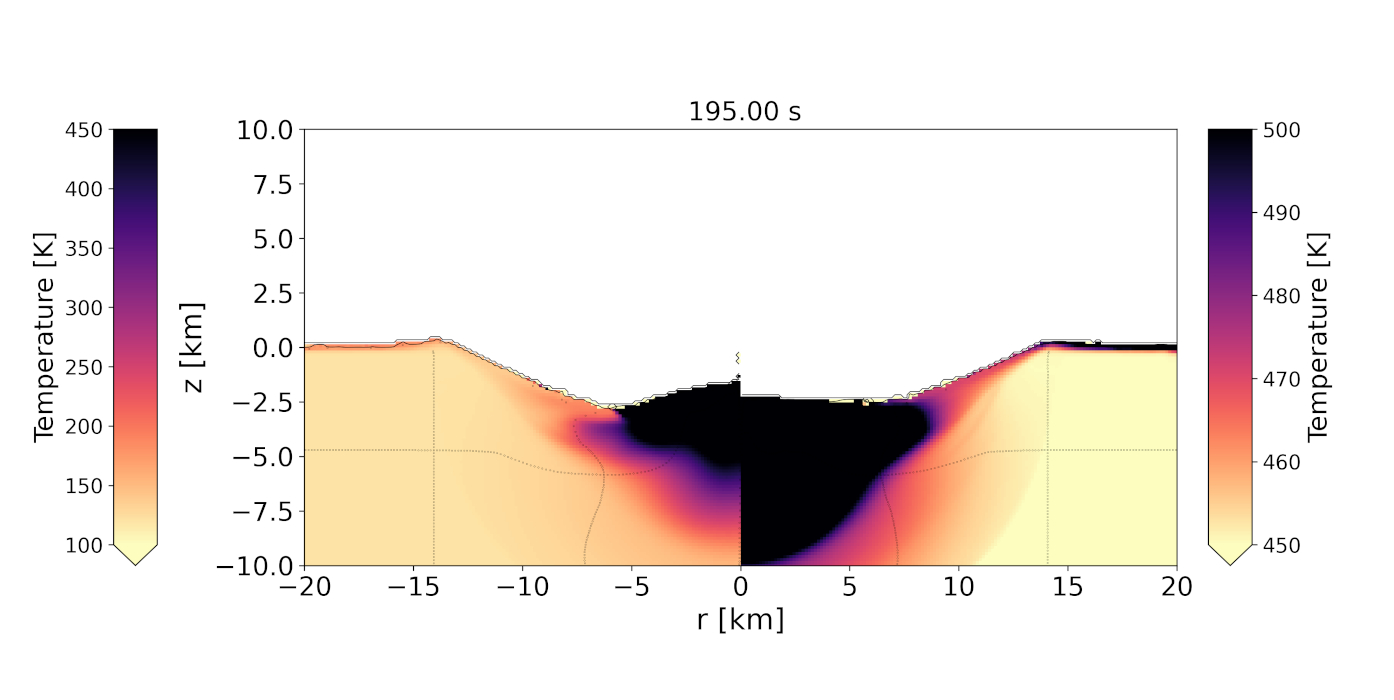Numerical modelling of impact craters within the Hermean Permanent Shadowed Regions
- INAF-OAPD, Padua, Italy (elena.martellato@inaf.it)
Introduction. Hermean Permanently Shadowed Regions (PSRs) have been suggested to contain water ice deposits, based on radar and neutron observations. These regions can provide thermally stable environments for water ice on geologic timescales [1]. Images and reflectance measurements highlighted the presence of bright and low-reflectance materials, suggesting that ice deposits can be both exposed at the surface and insulated by 10−30 cm of a carbon-rich material sublimation lag [1, 2, 3, 4].
Water ice could have been delivered by (1) a continuous flux of water-bearing micrometeoroids [5], or (2) few individual and large impacts of comets and/or hydrated asteroids [3, 6]. Based on the relative purity of water-ice deposits and the correlation between the polar crater age and the percentage extension of their PSRs, both sources could have contributed to the ice deposit formation (e.g., [7]).
A key point to determine which source is responsible of the water-ice delivery is the quantification of the projectile mass ratio that remains within the planet’s gravity. During an impact, a cometary nucleus is subject to extreme pressures and temperatures, which are sufficient to completely vaporize its constituent ices [8]. According to numerical simulations on the Moon, much of this vapor escapes lunar gravity within seconds, but a significant portion remains gravitationally bound as a transient atmosphere before migrating to cold traps [9, 10]. The final goal of this study is to investigate the fate of cometary projectiles when they impact on the Hermean surface and quantify the fraction that remains within the planet’s gravity.
Methods. A systematic numerical investigation has been carried out by means of iSALE shock physics code (e.g., [11, 12, 13, 14]). The target is assumed to be made by either a single basaltic sheet or by a more complex stratigraphy, including a water ice layer on top or within it. Different surface temperatures will be considered (Tmin=120 K, Tmean=300 K, Tmax=450 K [15]). The projectiles are assumed to be of ice composition, with diameters ranging from small (1 to 1000 µm) to large (>1 m) sizes, and velocities of 20 and 40 km/s, respectively, in the two cases [16].
Results. In this work, we present the very preliminary results of these numerical simulations. The modelling cases with the smaller projectiles aim at investigating the hypothesis (1), i.e., continuous flux of water-bearing micrometeoroids (Fig. 1). On the other hand, the impacts of larger projectiles represent the second case, where water ice is delivered to the surface by means of single events (Fig. 2).

Figure 1. Excavation stage of a 1 mm ice projectile impacting at 20 km/s on the surface, with temperature of 300 K. The left and right panels show the cases where a target cohesion of 1 kPa and 50 kPa was respectively set.

Figure 2. Excavation stage of a 1 m ice projectile impacting at 40 km/s on the surface, with temperature of 300 K. The left panel shows the model where the surface is assumed as regolith layer, described by the Drucker-Prager strength model, whereas the right panel reports the model where the surface was described by a pressure and damage-dependent strength model [13].
Discussion and Conclusions. According to the results presented by [7], a sample of craters on the northern Hermean pole exhibits an increasing trend between the crater age and the extent of the radar bright material on their PSRs, supporting hypothesis (1) However, a few of the studied craters are outliers, being much younger compared to the ice deposit.
One such example is Fuller crater, 27 km in diameter, located at 82.63°N, 317.35°E. Remote sensing data underlies the presence of a zone within its floor at very low temperature, where water ice could have remained stable over geological timescales. Preliminary numerical simulations to reproduce the craters suggests that it could have been formed by a km-sized comet (Fig. 3).
In the case the impact occurred in the night-side (Fig. 3, left panel), the post-impact temperatures are lower than 300 K on the floor of the modelled crater. This is area within the Fuller crater where ice deposit is expected.
Future work will include the investigation of the projectile fate.

Figure 3. Final stage of the model reproducing Fuller crater (D=27 km) by an impact of a comet of 1.4 km in size striking the surface at 20 km/s. The left and right panels represent the models with a surface temperature of 120 K and 450 K, respectively, in order to compare the cases of an impact occurred on the night or day side.
Acknowledgements.
The study is part of the INAF MINI-GRANTS (2023) “Origin of water ice on Mercury” (CUP C93C23008450001).
References.
[1] Chabot, N.L. et al. (2014) Geology 42, 1051−1054. [2] Deutsch, A.N. et al. (2019) Earth Planet Sci Lett 520, 26−33. [3] Neumann, G.A. et al. (2013) Science 339, 296−300. [4] Paige, D.A. et al. (2013) Science 339, 300−303. [5] Frantseva, K. et al. (2022) Icarus 383, 114980. [6] Ernst, C.M. et al. (2018) J Geophys Res Planets 123, 2628–2646. [7] Bertoli, S., et al. (2023) XVIII CNSP, 02/2023, Perugia, Italy. [8] Pierazzo E. & Melosh H.J. (2000) Meteoritics & Planet Sci 35, 117−130. [9] Ong L. et al. (2010) Icarus 207, 578−589. [10] Stewart, B.D, et al. (2011) Icarus 215, 1−16. [11] Amsden et al. (1980) Los Alamos Nat Lab Rep LA−8095, 101 pp. [12] Collins et al. (2016) iSALE-Dellen manual, figshare. [13] Collins et al. (2004) Meteorit Planet Sci 39, 217−231. [14] Wünnemann et al. (2006) Icarus 180, 514−527. [15] Cambianica, et al. Planet and Space Sci., under rev. [16] Borin, P. et al. (2016) A&A 585, A106.
How to cite: Martellato, E., Bertoli, S., Borin, P., and Cambianica, P.: Numerical modelling of impact craters within the Hermean Permanent Shadowed Regions, Europlanet Science Congress 2024, Berlin, Germany, 8–13 Sep 2024, EPSC2024-1263, https://doi.org/10.5194/epsc2024-1263, 2024.